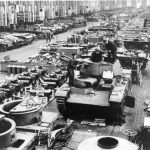Graham opens this entry discussing the impending address to the Reichstag that Hitler is due to give later that day. Although claiming that he won’t be listening to his “screams” on the wireless, Thomas’ political and intellectual curiosity appears to win out as we see later! Describing the speech as “about as impudent a concoction as ever issued from a himan (sic) mouth”. Seemingly claiming to have brought peace to Eastern Europe, Thomas determines that “no living man will ever trust his word or his signature again”. You can read the 90 minute speech in its entirety here.
Moving on to reflecting on the events that have occurred thus far, and on his own expectations of what may have happened by this stage, Thomas admits his predictions have not all played out as he expected. For example, as he has long discussed, he perceives one of the most significant threats in this conflict to be from the air. Having not yet occurred, Thomas theorises that “it may be that no attempt of this kind has yet been made in force because the enemy is uncertain of our air strength? Perhaps the tactics will now be a vast attack by air in order to try and overwhelm our air forces”. Fast forward to summer 1940, and through “Operation Sealion”, this was indeed the precise plan of Hitler, to then allow an essentially unchallenged invasion by land. This lead to The Battle of Britain where the RAF had other ideas.
As observant as ever, Thomas also makes reference to the fact that he has predicted “the future probability of enormous tanks, like land battleships” being introduced to the front lines. Although prohibited by The Treaty of Versailles from using tanks, the German army began to rebuild its forces when Hitler came to power in 1933.
Despite beginning manufacturing again relatively late due to these restrictions, it has been suggested that this actually proved to be beneficial to the Germans, as upon the outbreak of the war they were not hindered by obsolete models from World War One, as were the Allied nations. The army developed many versions of their tanks throughout the war; with “Panzer” divisions being dreaded by the Allies. Although arguably the huge “Tiger” tanks produced the most fear amongst their enemies, the earlier “Panther” tank is considered to have been the Germans’ best model.
Graham discusses the danger of such threats, both from tanks and from the air, as demonstrated in the “September campaign” that Germany and the Soviet Union launched against Poland. With Poland defeated on the date of this diary entry after having to face offensives from both sides, the country was annexed and divided up under the terms of the German-Soviet Frontier Treaty.
Sources used:
www.hitler.org
www.britannica.com
www.wikipedia.org
www.warsawinstitute.org





